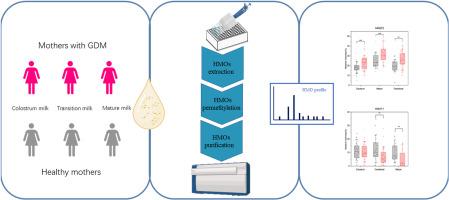Analysis of human milk oligosaccharides from women with gestational diabetes mellitus
IF 2.6
4区 生物学
Q2 BIOCHEMICAL RESEARCH METHODS
引用次数: 0
Abstract
Human milk oligosaccharides (HMOs) are bioactive components which play an important role in infant health. HMO composition is vulnerable to changes of maternal conditions including lactation stages and maternal phenotypes. Pregnant diseases such as gestational diabetes mellitus (GDM) are commonly found in women during pragnancy, and may cause disorder in maternal physiological metabolism which is harmful to infants. Unfortunately, anlysis of oligosaccharides from women with GDM is limited. To address this issue, we analyzed HMO compositions and profiles in breast milk from women with GDM using an established 96-well plate permethylation platform and MALDI-TOF-MS. We enrolled 127 women with GDM, and investigated HMO abundances in colostrum, transition milk, and mature milk respectively. We found that GDM affected HMO compositions in breast milk, and the level of fucosylation became higher over the course of lactation for all the women with GDM. Interestingly, the relative abundances of fucosylated HMOs in different lactation stages were affected differentially by GDM, with the most pronounced effect in colostrum. In particular, the relative abundances of H3N1F1 and H3N1F2 sharply decreased over time, showing very low levels in late lactation. These differences in our findings need further investigation to develop optimal feeding for mothers with GDM.

分析妊娠糖尿病妇女的母乳低聚糖。
母乳低聚糖(HMO)是一种生物活性成分,对婴儿健康起着重要作用。人乳寡糖的组成易受母体状况(包括哺乳阶段和母体表型)变化的影响。妊娠期疾病如妊娠糖尿病(GDM)常见于孕产妇,可能导致母体生理代谢紊乱,对婴儿造成危害。遗憾的是,对妊娠期糖尿病妇女体内低聚糖的分析十分有限。为了解决这个问题,我们使用已建立的 96 孔板过甲基化平台和 MALDI-TOF-MS 分析了 GDM 妇女母乳中的 HMO 成分和特征。我们招募了 127 名 GDM 妇女,分别研究了初乳、过渡乳和成熟乳中的 HMO 丰度。我们发现,GDM 影响了母乳中的 HMO 组成,所有 GDM 妇女在哺乳期的岩藻糖基化水平都会升高。有趣的是,GDM 对不同泌乳阶段的岩藻糖基化 HMO 的相对丰度有不同的影响,其中初乳的影响最为明显。特别是,H3N1F1 和 H3N1F2 的相对丰度随着时间的推移急剧下降,在泌乳后期的水平非常低。我们的研究结果中的这些差异需要进一步研究,以便为患有 GDM 的母亲制定最佳喂养方式。
本文章由计算机程序翻译,如有差异,请以英文原文为准。
求助全文
约1分钟内获得全文
求助全文
来源期刊

Analytical biochemistry
生物-分析化学
CiteScore
5.70
自引率
0.00%
发文量
283
审稿时长
44 days
期刊介绍:
The journal''s title Analytical Biochemistry: Methods in the Biological Sciences declares its broad scope: methods for the basic biological sciences that include biochemistry, molecular genetics, cell biology, proteomics, immunology, bioinformatics and wherever the frontiers of research take the field.
The emphasis is on methods from the strictly analytical to the more preparative that would include novel approaches to protein purification as well as improvements in cell and organ culture. The actual techniques are equally inclusive ranging from aptamers to zymology.
The journal has been particularly active in:
-Analytical techniques for biological molecules-
Aptamer selection and utilization-
Biosensors-
Chromatography-
Cloning, sequencing and mutagenesis-
Electrochemical methods-
Electrophoresis-
Enzyme characterization methods-
Immunological approaches-
Mass spectrometry of proteins and nucleic acids-
Metabolomics-
Nano level techniques-
Optical spectroscopy in all its forms.
The journal is reluctant to include most drug and strictly clinical studies as there are more suitable publication platforms for these types of papers.
 求助内容:
求助内容: 应助结果提醒方式:
应助结果提醒方式:


